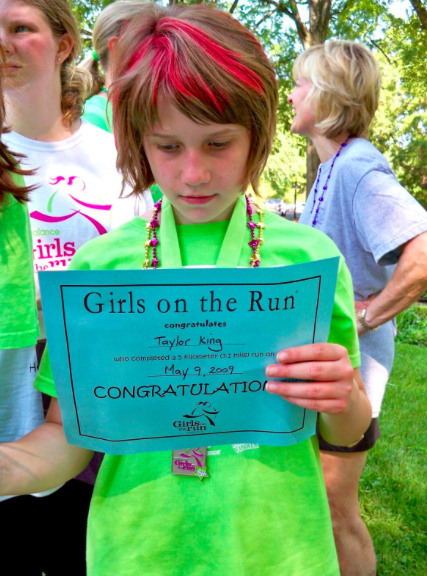Laura was already sixteen years old when her younger sister, Taylor, was born. She watched as her sister bloomed from a happy, healthy baby to a smart and talented three-year-old.
“She taught herself to read,” Laura remembers, “she was a fireball and a pistol. She just had this incredible personality, so smart and perfect. She was this perfect little gift to our family that none of us ever really expected.”
Taylor played the role of senior flower girl at Laura’s wedding. It was a beautiful day and her little sister was as rambunctious and delighted as could be.
On the one month anniversary of her wedding, Laura woke up, got dressed and counted her blessings. She felt, in that moment, that her life was perfect. She was married, had just bought her first house, and had a job she loved.
And then the call came that changed everything.
“I got the call [from my mother] at about 10:00AM that morning. She could barely put a sentence together,” Laura said. The problems had started when Taylor entered the first grade. She was having trouble with basic math. Laura had never seen a kid trying as hard as Taylor and she was inconsolable when she realized she couldn’t do it.
“That was really the first thing that happened,” Laura said.

Then, in the beginning of her second grade year, the whole family went to the state fair in Raleigh. It was a fall tradition. They went into a dark area where a booth was serving hush puppies. As they were leaving the area Laura noticed that Taylor couldn’t find the stairs.
“She didn’t complain or say anything because that was her way, she just tried to figure it out herself.”
Her parents wasted no time in getting tests run. Taylor was initially diagnosed with a rare disease called retinitis pigmentosa—also called rod cone dystrophy.
Laura tried to comfort her worried parents by telling them the story of a girl she had gone to college with who had gone blind. She was able to go to school and get a job and have normal and fulfilling life. Things were going to be different—but they were going to be okay.
But then, more genetic tests were run and Taylor’s diagnosis changed completely.
The phone call Laura received that morning from her mother had her tripping over the words “Neuronal ceroid lipofuscinosis”—also known as Infantile Batten disease. The inherited neurodegenerative condition mainly affects infants, toddlers and children. It is always fatal.
According to the Taylor’s Tale website, “The symptoms of Batten disease are caused by the buildup of fatty substances called lipopigments in the body’s tissues. As these substances accumulate, they cause the death of cells called neurons in the brain, retina and central nervous system. Batten disease is one of the most common lysosomal storage disorders.”
Laura recalls what the geneticist who diagnosed Taylor told their parents “Go home and make happy memories because there is nothing you can do. I’m sorry.”
It was 2006, an era long before research on the disease had really started. The actual gene had only been discovered in 1995 and at that point nothing had really happened as far as medical advancements, the patient community was at a standstill.
Laura and her family took that afternoon to meet, grieve, and turn their anxiety into action by strategizing what their next move was going to be.
“There really wasn’t a blueprint on what to do next, as far as the bigger picture. But the immediate picture for us was clear: there are a lot of things we can do to try and make this better,” said Laura. “I think a lot of it was about, not so much what the adults were doing, but what [Taylor], the patient, was doing. Making sure that absolutely every bit of potential is maximized. And never once saying ‘I can’t do something because I’m sick.’”
The foundation of the organization, Taylor’s Tale, that the King family was about to create was based around one idea: no cure was not good enough.“So we set out to really blow that to pieces,” said Laura.
Taylor wasn’t going down without a fight. She ran multiple races in school for a group called Girls on the Run. After she became blind, she continue to run and completed her first 5k. With a guide, she kept running and inspired Laura to run for the cause as well.
On the five year anniversary of Taylor’s first run—Laura decided to walk a mile in her shoes—or rather run a half-marathon blindfolded. After she ran the half-marathon and she crossed the finish line, the blindfold came off—and Laura felt as though she was seeing the world in a new way for the first time.
Today, together with other dedicated advocates, Taylor’s Tale is uniting elected officials, healthcare providers, public health officials, researchers, biotech industry reps and patient advocates to create real, lasting progress in the development of breakthrough treatments and life-changing legislation for rare disease patients.
They have funded innovate research at multiple institutions including Kings College London, the NIH, University of North Carolina at Chapel Hill, University of Rochester, University of Texas Southwestern and Washington University in St. Louis.
Together with Abeona Therapeutics Inc., a clinical-stage biopharmaceutical company, and multiple other rare organizations, the King family and Taylor’s Tale are proud to announce the introduction of a new gene therapy treatment developed at the University of North Carolina at Chapel Hill by Steven Gray Ph.D.
“We’ve known for a long time that our work will not save Taylor. But we keep going. Taylor [will] never quit, and neither will we.”
Stay updated on the release of Laura’s book, “Run to the Light” here.
Learn more about Taylor’s Tale and their mission online here.

Stay Connected
Sign up for updates straight to your inbox.

